|
|
|
|
Late Entries to a Survey of Bestiaries
The staff of the Poison Pie Publishing House assembled a survey of one hundred bestiaries, posting an entry on their blog for each day from June 1, 2016 to September 8, 2016. When they were done, there were additional bestiaries that they did not want to omit entirely. This page lists latecomers to the survey added monthly in 2024.
|
|
|
|
|
January 6, 2024
Pokénatomy II
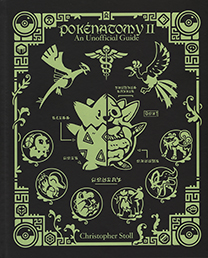 author: Christopher Stoll
author: Christopher Stoll
interior artist: Christopher Stoll
cover artist: Aaron Hain
publisher: self-published
publication date: 2022
cover: hardcover
number of pages: 216
ISBN-10: none
ISBN-13: none
description: This second unofficial Pokédex contains anatomical descriptions of 100 Pokémon from the Johto region.
Our featured entry from this bestiary is girafarig.
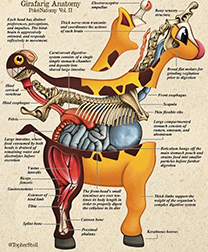 CHARACTERISTICS
CHARACTERISTICS
Girafarig are twin-headed mammalian Pokeémon remakrable for their gestalt consciousness partitioned across two fully functional brains. Each head is capable of functioning while the other is asleep, and they take turns watching for threats.
PHYSIOLOGY
Girafarig is considered omnivorous. The forward-facing head is capable of eating seeds, nuts, leaves, and other vegetative matter. Their hind-head is carnivorous and will consumer carrion, eggs, insects, and even live mammals. Both heads' digestive tracts converge in a single colon where waste is combined and excreted.
Girafarig are distantly related to Stantler, and it is believed that their unique physiology may have originated when an extra-dimensional organism such as Unown successfully fused with their ancestor.
Each head contains a singular consciousness capable of communicating and even solving simple puzzles under laboratory conditions. Their nervous systems are
interconnected via the spinal column, which allows for the sharing of sensory data and emotions, as well as strategic coordination in life-or-death situations.
BEHAVIOR
Mating takes place in spring. In a complex courtship display, males dance while rapidly raising and lowering both of their heads. Only the front head is attached to the respiratory system and capable of making sounds. The front head lets out a series of inviting calls, while the tail chatters its teeth. These dances typically end in rejection, as both of the female's heads must find a potential partner attractive in order to mate. If they enjoy the male's display, the two Girafarig will bond. The couple then dig and defend a nest, remaining monogamous partners until their first young have hatched and are strong enough to survive on their own.
|
|
|
|
|
February 3, 2024
Tome of Beasts III
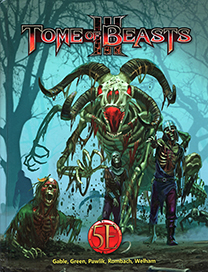 lead designers: Scott Gable, Richard Green, Kelly Pawlik, Sebastian Rombach, Mike Welham et al.
lead designers: Scott Gable, Richard Green, Kelly Pawlik, Sebastian Rombach, Mike Welham et al.
development lead: Meagan Maricle
interior artists: Miguel Regodón Harkness et al.
cover artist: Chris Rallis
publisher: Kobold Press
publication date: 2022
cover: hardcover
number of pages: 424
ISBN-10: 1-950789-39-X
ISBN-13: 978-1-950789-39-9
description: This bestiary presents more than 400 beasts. The book is compatible with 5th edition of Dungeons and Dragons.
Our featured entry from this bestiary is the tuberkith.
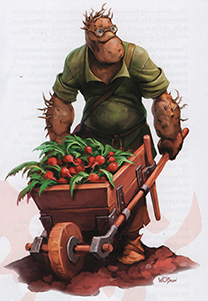 Tuberkith are root vegetables given sentience by fey magic.
After a rural village offended the local fey court, its unseelie
ruler condemned the villagers to watch their year's harvest
uproot itself and walk away, leaving them to starve. Potatoes,
beets, yaro, and yams crawled free from the soil and strolled
about the village.
Tuberkith are root vegetables given sentience by fey magic.
After a rural village offended the local fey court, its unseelie
ruler condemned the villagers to watch their year's harvest
uproot itself and walk away, leaving them to starve. Potatoes,
beets, yaro, and yams crawled free from the soil and strolled
about the village.
The fey lord's curse did not work out as intended: Instead
of fleeing into the surrounding wilderness, the tuberkith
became quite social. They exhibited a natural predisposition for
managing crops and happily supported the villagers' farming
efforts in growing additional food. The tuberkith settled among
the villagers and formed families, becoming a blessing in the
long run.
FRIENDS IN THE FIELD. Tuberkith form strong relationships
with the communities around them, who cherish the tuberkith's
natural connection to the fields they work. They seem to
especially enjoy working with humans, halflings, and erina.
PLANTING OFFSPRING. When reproducing, both tuberkith
parents plant an eye in the ground. The parents tend to the
burgeoning roots for three months, then they pull the new
offspring from the ground.
DEFENSIVE WEAPONS. Like other cultures, tuberkith have
developed weapons to defend themselves from predators and
foes. The tuberkith wield two-handed mashers, which can knock
their foes to the ground, while allies use one-handed peelers to
effortlessly slice flesh from the prone enemies.
|
|
|
|
|
March 2, 2024
Monster Manual Expanded
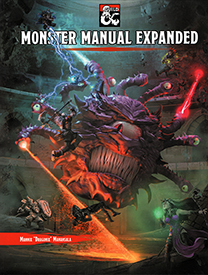 authors: Mannix "Dragonix" Manansala
authors: Mannix "Dragonix" Manansala
interior artist: Art of Neight et al.
cover artist: Ruben de Vela
publisher: Dungeon Masters Guild
publication date: 2019
cover: hardcover
number of pages: 320
ISBN-10: 0-01-064137-8
ISBN-13: 237-0-01-064137-0
description: This bestiary contains descriptions of 470 creatures. This book is compatible with the 5th edition of the Dungeons & Dragons Role Playing Game.
Our featured entry from this bestiary is the urophion.
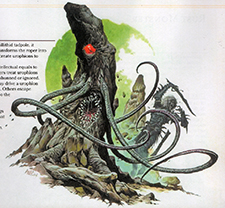 When a roper is infected with an illithid tadpole, it undergoes ceremorphosis and transforms the roper into a urophion. Mind flayers usually create urophions to serve as guards.
When a roper is infected with an illithid tadpole, it undergoes ceremorphosis and transforms the roper into a urophion. Mind flayers usually create urophions to serve as guards.
Urophions see themselves as intellectual equals to mind flayers. However, mind flayers treat urophions as social outcasts are either shunned or ignored. Years of this kind of treatment may drive a urophion insane, causing it to attack its kin. Others escape their servitude and wander off into the Underdark. If they encounter an intelligent creature, they may not be automatically hostile, as it longs to have a decent conversation. That is until it realizes it is hungry and starts to crave the creature's brain.
|
|
|
|
|
April 6, 2024
Monster Manual Expanded II
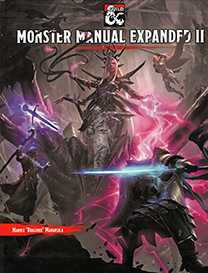 authors: Mannix "Dragonix" Manansala
authors: Mannix "Dragonix" Manansala
interior artist: Arthur Azaryan et al.
cover artists: Joshua Raphael & Wilson Nugrahaa
publisher: Dungeon Masters Guild
publication date: 2019
cover: hardcover
number of pages: 312
ISBN-10: 0-01-064139-4
ISBN-13: 237-0-01-064139-4
description: This bestiary contains descriptions of 390 creatures. This book is compatible with the 5th edition of the Dungeons & Dragons Role Playing Game.
Our featured entry from this bestiary is the doomsphere.
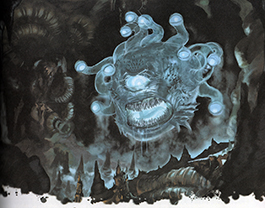 Urban legends speak of the bodies of adventurers who were
unfortunate enough to encounter the ghostly globe of death.
Lifeless bodies frozen in fear and anguish, no one can tell how
they came to their gruesome ends. Perhaps this spectral beholder
passed through their bodies, its necrotic touch corrupting flesh
and bone. Or perhaps one look at its pale, abhorrent visage was
enough to drain the life out of its victims.
Urban legends speak of the bodies of adventurers who were
unfortunate enough to encounter the ghostly globe of death.
Lifeless bodies frozen in fear and anguish, no one can tell how
they came to their gruesome ends. Perhaps this spectral beholder
passed through their bodies, its necrotic touch corrupting flesh
and bone. Or perhaps one look at its pale, abhorrent visage was
enough to drain the life out of its victims.
Mad Orb of Undeath. A doomsphere is the restless spirit of
a beholder that spawned after its death due to a curse or was
created by powerful necromantic magic. In extremely rare
instances, a beholder that sought lichdom but failed in the ritual
would instead return as a doomsphere. The creature retains
almost all of its arsenal of abilities, save a few that have changed
due to undeath. Most, but not all, tend to become insane after this
ghastly reincarnation.
The doomsphere continues to "live" beyond death as the vile
xenophobic beholder it once was, only far more dangerous and
more isolated this time and adventurers know better than to
invade its old stomping grounds, which it haunts to this day.
|
|
|
|
|
May 4, 2024
Monster Manual Expanded III
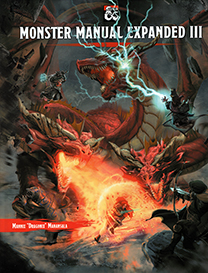 authors: Mannix "Dragonix" Manansala
authors: Mannix "Dragonix" Manansala
interior artist: Brian "Tots" Valeza et al.
cover artist: Ruben de Vela
publisher: Dungeon Masters Guild
publication date: 2021
cover: hardcover
number of pages: 288
ISBN-10: 0-01-132941-6
ISBN-13: 237-0-01-132941-3
description: This bestiary contains descriptions of 320 creatures. This book is compatible with the 5th edition of the Dungeons & Dragons Role Playing Game.
Our featured entry from this bestiary is the nagahydra.
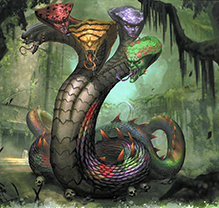 The nagahydra is a fearsome monstrosity that appears as a 50-foot
long, five-headed naga. Multicolored, reticulated scales cover the
nagahydra's 3-foot diameter body, with singular hues branching
out to each of the five heads - bright crimson, deep purple, emerald
green, onyx black, and golden yellow. Fiery-orange spines line the
back of its serpentine body. Each head of the nagahydra can be
male or female and has its own personality and motivations. The
heads may at times argue and bicker with one another, but never
to the point of attacking each other.
The nagahydra is a fearsome monstrosity that appears as a 50-foot
long, five-headed naga. Multicolored, reticulated scales cover the
nagahydra's 3-foot diameter body, with singular hues branching
out to each of the five heads - bright crimson, deep purple, emerald
green, onyx black, and golden yellow. Fiery-orange spines line the
back of its serpentine body. Each head of the nagahydra can be
male or female and has its own personality and motivations. The
heads may at times argue and bicker with one another, but never
to the point of attacking each other.
Cruel Overlord. While not inherently evil, the nagahydra is still a
cruel, selfish, and vicious monster. It relishes hunting lesser beings
for food, stalking its prey through ancient forests and dismal
swamps. It enjoys being worshiped by those who seek its blessing
and security. In return, the nagahydra aids and protects its
subjects from hostile creatures, sickness, and natural calamities.
However, the nagahydra demands sacrifice and tribute from its
followers, punishing those who fail to do so severely.
|
|
|
|
|
June 1, 2024
Chains of Asmodeus
 project lead: James Ohlen
project lead: James Ohlen
interior artists: Aaron Sims et al.
cover artist: Aaron Sims Company
publisher: Dungeon Masters Guild / Arcanum Worlds
publication date: 2023
cover: hardcover
number of pages: 288
ISBN-10: 0-01-605528-4
ISBN-13: 237-0-01-605528-7
description: This book provides an adventure through the nine hells. Relevant to this survey, Appendix A includes descriptions of twelve arch-devils. Appendix B includes descriptions of fifteen hellish beasts. Appendix C includes descriptions of six non-player characters. This book is compatible with the 5th edition of the Dungeons & Dragons Role Playing Game.
Our featured entry from this bestiary is the arch-devil, Fierna, daughter of Belial, ruler of Phlegethos.
 Fierna rules Phlegethos alongside her father, Belial.
She is emotionally intelligent, and her charisma has
earned her many allies and few enemies in the Nine
Hells. Although some view her as incompetent, Fierna’s
true intentions are hidden behind a smokescreen
of brashness.
Fierna rules Phlegethos alongside her father, Belial.
She is emotionally intelligent, and her charisma has
earned her many allies and few enemies in the Nine
Hells. Although some view her as incompetent, Fierna’s
true intentions are hidden behind a smokescreen
of brashness.
Her father, Belial, was a key player in the Reckoning,
and due to his actions, Fierna was granted primary
leadership of Phlegethos. Despite this political
appearance, Fierna and Belial rule together, often
meeting in secret to discuss strategy and upcoming
plans. Some of the more ignorant archdevils view
the relationship between Belial and Fierna as something
to be exploited or broken. In reality, Fierna
deeply respects her father, and the feeling is mutual.
Laying eyes on Fierna, one can immediately see
the reasons she is so admired: she is impossibly
beautiful. Her beauty is a strength, complementing
her strategic mind and ingenuity.
|
|
|
|
|
July 6, 2024
Minsc and Boo's Journal of Villainy
 project lead: James Ohlen
project lead: James Ohlen
interior artists: Sebastian Kowoll et al.
cover artist: Luis Lasahido
publisher: Dungeon Masters Guild
publication date: 2021
cover: hardcover
number of pages: 156
ISBN-10: 0-01-126442-X
ISBN-13: 237-0-01-126442-4
description: This book is a source book for adventurers, with a theme of villainy. Most of the book presents collections of characters or monsters, categorized as "Group Patrons" (Chapter 2), "Campaign Villains" (Chapter 3), "Henchmen" (Chapter 4) and "Monsters" (Chapter 5). This book is compatible with the 5th edition of the Dungeons & Dragons Role Playing Game.
Our featured entry from this bestiary is the sirene.
 Sirenes are fey creatures that live along the cliffs and
jagged rocks of the Sword Coast. Equally comfortable
on land or beneath the waves, sirenes prefer to keep
close to shore and rarely go out into deep water. They
are famed for their beautiful singing that often lures
sailors to steer their ships to disaster on the coast.
Sirenes are fey creatures that live along the cliffs and
jagged rocks of the Sword Coast. Equally comfortable
on land or beneath the waves, sirenes prefer to keep
close to shore and rarely go out into deep water. They
are famed for their beautiful singing that often lures
sailors to steer their ships to disaster on the coast.
Territorial. Sirenes live together in small bands. They
are extremely territorial and try to drive out any other
humanoid that trespasses in their domain. They initially
use non-deadly means to convince intruders to leave, but
if that is not successful, they are willing to kill.
Beautiful Song. Sirenes love to sing and use their
music to communicate amongst themselves. Their
songs are beautiful and haunting, but usually not magical
in nature. Only when they are in danger will they
weave magic into their songs.
Skilled Warriors. Sirenes are deadly warriors who
use their skills to hunt for food and to kill those who
trespass on their territory. Their wicked daggers are
made from bone and are their primary weapon when
they travel beneath the water. They store their bows
close to shore, ready to be retrieved if needed.
|
|
|
|
|
August 3, 2024
Mediterranean Monsters
 authors: Jason Nelson et al.
authors: Jason Nelson et al.
interior artists: Simon Aan et al.
cover artist: credit unclear (Yoirami?)
publisher: Legendary Games
publication date: March, 2024
cover: softcover
number of pages: 182
ISBN-10: 1-955320-21-7
ISBN-13: 978-1-955320-21-4
catalog number: LGP593MED015E
description: This bestiary contains descriptions of more than 100 creatures drawn from the myths and legends of the Mediterranean region. It is compatible with the 5th edition of the Dungeons & Dragons Role Playing Game.
Our featured entry from this bestiary is the Hesperid Queen.
 Hesperides are nymphs of sunset, guardians of the colorful
golden hues of the setting sun. They live on remote islands,
isolated coastal cliffsides, and hidden valleys, all places
where the sunset's golden glow can have the strongest effect.
Hesperides manipulate sunlight with dancelike motions,
allowing them to create graceful ribbons of light at close
range and searing rays at a distance. Due to their connection
to the beauty of the daily cycle of the setting sun, hesperides
feel a satisfaction from methodical routine that can feel alien
to wilder, more chaotic fey.
Hesperides are nymphs of sunset, guardians of the colorful
golden hues of the setting sun. They live on remote islands,
isolated coastal cliffsides, and hidden valleys, all places
where the sunset's golden glow can have the strongest effect.
Hesperides manipulate sunlight with dancelike motions,
allowing them to create graceful ribbons of light at close
range and searing rays at a distance. Due to their connection
to the beauty of the daily cycle of the setting sun, hesperides
feel a satisfaction from methodical routine that can feel alien
to wilder, more chaotic fey.
Hesperid Queens. Hesperid queens rule over isolated
regions soaked in the light of sunset. They guard countless
treasures and secrets, though for those who approach them
with respect and offer an intriguing bargain, they're willing
to part with knowledge or items beyond those secrets or
valuables they've sworn to keep to themselves.
Hesperid queens are relatively likely to have powerful
objects under their protection, such as ancient relics or
artifacts. As such, they're keenly aware of the danger posed
by unscrupulous treasure hunters seeking to obtain these
items at any cost, and they use their incredible minds to set
up devious countermeasures to protect their wards, even in
the event of their own deaths.
|
|
|
|
|
September 7, 2024
Mechanical Monsters
 authors: Jason Nelson et al.
authors: Jason Nelson et al.
interior artists: Simon Aan et al.
cover artist: uncredited
publisher: Legendary Games
publication date: March, 2024
cover: softcover
number of pages: 158
ISBN-10: 1-955320-16-0
ISBN-13: 978-1-955320-16-0
catalog number: LGP574MMB015E
description: This bestiary contains descriptions of more than 140 creatures, including constructs, clockworks and cybernetics. It is compatible with the 5th edition of the Dungeons & Dragons Role Playing Game.
Our featured entry from this bestiary is the cranial dissectibot.
 A cranial dissectibot is an example of the light and dark
sides of chirurgical practice. In principle, it is a semi-sentient
mechanical assistant, programmed and equipped to assist a
surgeon in medical matters both simple and complex, whether
it be treating poisons or injuries or dealing with disease or
dissection. Of course, in the hands of a demented chirurgeon,
the cranial cranial dissectibot becomes a terrifying instrument
of torment, capable of reducing the bravest of souls to drooling
impotence with soulless and heartless clinical precision.
A cranial dissectibot is an example of the light and dark
sides of chirurgical practice. In principle, it is a semi-sentient
mechanical assistant, programmed and equipped to assist a
surgeon in medical matters both simple and complex, whether
it be treating poisons or injuries or dealing with disease or
dissection. Of course, in the hands of a demented chirurgeon,
the cranial cranial dissectibot becomes a terrifying instrument
of torment, capable of reducing the bravest of souls to drooling
impotence with soulless and heartless clinical precision.
This mechanical horror bristles with wires, compartments,
and blinking lights up and down its thick stalk-like metallic
body, balanced atop six spidery legs and bristling with
branching armatures, some with cables and clamps and others
tipped with gleaming trocars and pneumatic needlers. A cranial
dissectibot is 7 feet tall in total, its core body 3 feet tall, atop a
set of legs 2 feet long and with the upper 2 feet a branching set
of limbs and sensors. A cranial dissectibot weighs 500 pounds.
|
|
|
|
|
October 5, 2024
Faerie Bestiary
 authors: Matt Kimmel et al.
authors: Matt Kimmel et al.
interior artists: Simon Aan et al.
cover artist: uncredited
publisher: Legendary Games
publication date: March, 2024
cover: hardcover
number of pages: 300
ISBN-10: 1-955320-12-8
ISBN-13: 978-1-955320-12-2
catalog number: LGP562FB015E
description: This bestiary contains descriptions of nearly 240 creatures from the Fey Realm. It is compatible with the 5th edition of the Dungeons & Dragons Role Playing Game.
Our featured entry from this bestiary is the choxani.
 Also called "picture people," choxani embody those aspects
of nature that resemble other things, from a chameleon
changing color to a cloud blown into the shape of a dog.
Choxani see these moments of representation as proof of the
plan underlying all reality, and honor them with religious
fervor. They communicate primarily through hand gestures
and their constantly changing markings, which can form
text or images. In their natural state they appear as spindly
humanoid with dragonfly wings and woody skin covered in
shifting colors and patterns. When eating, the colors on their
fingers or faces stretch out into funnels, sucking in the colors
of other organisms and leaving them lifeless gray husks. A
typical choxani is 7 feet tall and weighs 150 pounds.
Also called "picture people," choxani embody those aspects
of nature that resemble other things, from a chameleon
changing color to a cloud blown into the shape of a dog.
Choxani see these moments of representation as proof of the
plan underlying all reality, and honor them with religious
fervor. They communicate primarily through hand gestures
and their constantly changing markings, which can form
text or images. In their natural state they appear as spindly
humanoid with dragonfly wings and woody skin covered in
shifting colors and patterns. When eating, the colors on their
fingers or faces stretch out into funnels, sucking in the colors
of other organisms and leaving them lifeless gray husks. A
typical choxani is 7 feet tall and weighs 150 pounds.
|
|
|
|
|
November 2, 2024
Don't Bump the Gump and Other Fantasies
 author: Shel Silverstein
author: Shel Silverstein
interior artist: Shel Silverstein
cover artist: Shel Silverstein
publisher: Harper Collins
publication date: 1964
cover: harcover
number of pages: 64
ISBN-10: 0-06-149338-4
ISBN-13: 978-0-06-149338-6
description: This bestiary contains a collection of fantastical beasts, some of ominous demeanor and other less so.
Our featured entry from this bestiary is the terrible feezus.
 The Terrible Feezus
The Terrible Feezus
There is a terrible twenty-foot Feezus.
Shhh ... I don't think he sees us.
|
|
|
|
|
December 7, 2024
Creatures, Beasts, and Monsters 2024 Daily Calendar
 lead designer & authors: uncredited
lead designer & authors: uncredited
interior artists: Daniel Landerman et al.
cover artist: uncredited
publisher: Wizards of the Coast/Andrews McMeel Publishing
publication date: 2023
format: day by day calendar
number of pages: 313
ISBN-10: 1-5248-8377-8
ISBN-13: 978-1-5248-8377-5
description: This daily calendar highlights a difference beast for each day of 2024. The entries for Saturday and the following Sunday are combined, resulting in a total of 313 entries. The images in this calendar are taken from other publications of the Dungeons & Dragons Role Playing Game.
Our featured entry from this bestiary is the Red Abishai.
 Red abishais lead other devils into battle or take charge of troublesome cults to ensure that they continue to carry out Tiamat's commands.
Red abishais lead other devils into battle or take charge of troublesome cults to ensure that they continue to carry out Tiamat's commands.
|
|
|
|
|
Continue to 2025 entries.
|
|
|
|
|
|
|
|

